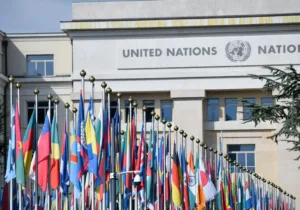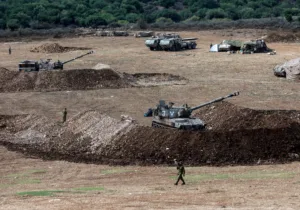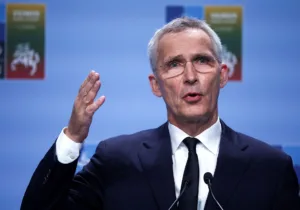The White House warned late Monday that Syrian President Bashar al-Assad appeared to be preparing another chemical weapons attack—and that the United States would respond to such a provocation. “As we have previously stated, the United States is in Syria to eliminate the Islamic State of Iraq and Syria,” said press secretary Sean Spicer in a statement. “If, however, Mr. Assad conducts another mass murder attack using chemical weapons, he and his military will pay a heavy price.”
UN Ambassador Nikki Haley also said on Twitter Monday that, “Any further attacks done to the people of Syria will be blamed on Assad, but also on Russia & Iran who support him killing his own people.”
Iran has spent billions of dollars a year propping up Syrian dictator Bashar al-Assad. Why are the two regimes so close? Here’s what you should know about this geopolitical alliance.
1. They are unlikely allies
Iran and Syria are unlikely allies. Syria is a secular, pan-Arab, socialist republic while Iran is a Persian theocracy that rejects secularism and favors universal Islamization. The difference between the two groups is so great that former Syrian President Hafez Assad did not even visit Iran while Ayatollah Khomeini was alive because the latter did not consider the Syrian leader to be a true Muslim.
2. They share common enemies
What the two countries do share in common, and what maintains their strategic alliance, are shared common “enemies”: Israel, the United States, Iraq (especially under Saddam Hussein), and the Islamic State (ISIS). Both countries want to contain the influence of Iraq and Israel and to hinder American involvement in the region as well as stop the spread of the ISIS caliphate.
3. They are (relatively) old friends
The peculiar alliance between Syria and Iran has lasted almost forty years.
In 1979 Syria terminated its strategic partnership with Egypt when Egyptian President Anwar Sadat signed a peace treaty with Israel. At the same time, Iran’s Islamic Revolution was overthrowing the pro-Western Shah (i.e., Iran’s monarch). Since both countries shared a hatred for Israel (and Israel’s friend, the U.S.), President Assad took the initiative in reaching out to Iran by sending Khomeini a gold-illuminated Koran and a pledge of cooperation. Iran agreed to the arrangement because they wanted to gain access to Syria’s neighbor, Lebanon. Southern Lebanon is considered to be one of the holiest areas of Shi’a Islam, the form most common in Iran.
4. They have a defensive alliance
Because the main political objective they share is neutralizing common enemies, Syria and Iran’s alliance is mostly defensive.
When Iraq invaded Iran in 1980, Syria became the only Arab country to side with Iran against their longtime antagonist, Saddam Hussein. Similarly, Iran sided with Syria against anti-Assad forces in Lebanon. And they have also been united, especially since 2001, in their opposition to the United States and Israel expanding influence in the region. In 2002, the two countries signed a military agreement specifically to thwart the perceived dangers of Israel. “Our cooperation is based on a strategic pact and unity against common threats. We can have a common front against Israel’s threats,” said Syrian Defense Minister Hassan Turkmani.
5. They aren’t competing ideologically.
Many national alliances are formed over an ideological bond or a shared set of objectives (e.g., NATO). But in geopolitics not sharing common ideological goals can also be an advantage. For example, Syria is primarily interested in leading a mostly secular pan-Arab nationalism movement, while Iran is more concerned with the spread of their brand of Islam. As Jubin M. Goodarzi says, “Overall, there has been neither ostensible competition on the ideological level (except in Lebanon during 1985 to 1988) nor fear that one partner might upstage the other, precisely because of distinctly different ideological platforms.” This allows both countries to be regional leaders on issues that most concern them.
6. They have a “child” together.
“It was in Lebanon where Iran and Syria collaborated most closely,” says Mohsen Milani. “Hezbollah is the child of that collaboration.”
Hezbollah (“Party of God”) is a political and military organization in Lebanon comprised mainly of Shi’a Muslims. It emerged in the 1980s as Iran’s proxy to fight Israel in Lebanon. The core of the military wing of Hezbollah was trained in 1982 by a 1,500-member contingent of Iran’s Revolutionary Guards, who were allowed access to the country by Syria’s government. Once Israel left Lebanon in 2000, Hezbollah became a dominant force—a “state within a state”—and was strengthened by its ties to Syria and Iran. Hezbollah has also played a key role in the Syrian civil war, fighting against Islamic State (ISIS) on behalf of the Assad regime.
Together, the Iran, Syria, and Hezbollah form what anti-Westerners in the region refer to as the “axis of resistance” (a term coined in response to President George W. Bush’s claim that Iran, Iraq, and North Korea formed an “axis of evil”).
—
Joe Carter is an adjunct professor of journalism at Patrick Henry College, an editor for several organizations, and the author of the NIV Lifehacks Bible.
Photo Credit: Poster hanging on the outside of a kebab shop in Damascus, Syria in May 2007. By Sean Long, via Flickr.







 Live in the DC area? Sign-up for Providence's in-person events list!
Live in the DC area? Sign-up for Providence's in-person events list!